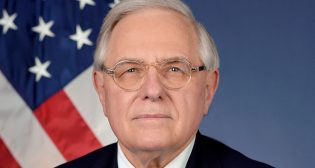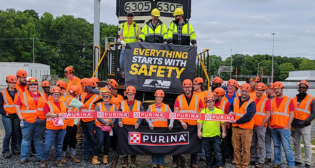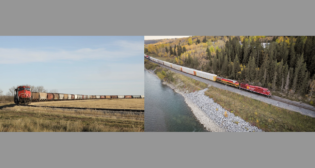
Short Lines Are Dependable and Get the Job Done
Written by Chuck Baker, President, ASLRRA
ASLRRA President Chuck Baker
ASLRRA PERSPECTIVE, RAILWAY AGE DECEMBER 2023 ISSUE: The story of “The Little Engine That Could” began as an American folktale popularized by various authors in the 1900s. An early published version of the tale appeared in 1906 under the title “Thinking One Can” in Wellspring for Young People, a national Sunday School Publication. A subsequent version was published in 1910 in the Kindergarten Review under the title “The Pony Engine.” In 1930, the story became widely known under the title “The Little Engine That Could” after a Chicago publishing house released it as an illustrated children’s book that was used in schools to teach children the value of optimism and hard work.
While the story of the little engine has been told and altered many times, the underlying theme is the same: A stranded train is unable to find a large engine willing to take it over difficult terrain to its destination. Only the little engine is willing to try, and while repeating the mantra “I think I can, I think I can,” overcomes a seemingly impossible task.
For many years the modern short line industry has worked hard to erase the image of short lines as the toy trains of children’s stories or a quaint name on the Monopoly board. Nevertheless, it is impossible to ignore the parallels between the children’s story and the real story. Today, short lines are critical first-mile/last-mile service providers striving to be excellent partners and connectors to shippers and the national Class I railroad network. That link is increasingly understood and appreciated by the many stakeholders in the transportation industry.
At our November regional meeting in Lexington, Ky., ASLRRA hosted a panel discussion with customers shipping aluminum, plastics, coal and stone products. Their comments encapsulated the modern short line story:
• “Our company has grown up together with our short line.”
• “We can call our short line literally anytime because it’s a partnership.”
• “Short lines are actually easy compared to trucks.”
• “Our short line is dependable and gets the job done.”
• “Our short line makes it easy; they answer the phone.”
• “Price is key for us, but we use rail for more than just cost. It helps with our carbon goals. It’s important to the safety of our facilities because we have fewer trucks and drivers around.”
• “We will not build a facility unless there is short line service available.”
After a tumultuous six years or so, the Class I railroads are now increasing their focus on growing volume on the network and providing the service that shippers demand, and increasingly recognizing that short lines are a key partner for delivering on both of those goals. For instance, CN just revived its previously shuttered Short Line Conference and sent an unusually large (20-plus) and high-level (four SVPs) delegation to our 2023 Annual Conference in New Orleans, La. Norfolk Southern is likewise reinvigorating its Short Line Caucus and appointed former Watco EVP and former ASLRRA Chairman Stefan Loeb, as VP of First and Final Mile Markets. CSX’s Joe Hinrichs, a keynote speaker at our 2023 Annual Conference, is similarly placing new emphasis on short line connections, and has just reorganized the railroad’s strategy team to put short lines under the very qualified leadership of Farrukh Bezar, Tom Tisa and Mike Clements.
Government regulators are also increasingly engaged with and supportive of short line railroads. For instance, in the Surface Transportation Board’s recent reciprocal switching proposal, short lines were largely excluded as the STB explained that it has not heard any meaningful amount of formal or informal complaints about short lines from their shippers. Likewise, the Federal Railroad Administration (FRA) has rightly given short line railroad projects an increasingly large share of CRISI grant funds. Between CRISI’s 2017 launch and 2021, 103 short lines received grants totaling more than $672 million. The recently announced FY22 awards were record breaking for our industry: Short lines garnered 47 of the 70 projects awarded for $720 million, about half of the $1.4 billion available. To paraphrase one FRA official speaking in a CRISI application debriefing: “Short line project benefits are significant, easily measured and begin almost immediately after project completion.”
The availability of short line rail service benefits local economies. The Lancaster & Chester Railroad (L&C) completed a CRISI project in 2021 in South Carolina. Former Chester County Council Member Alex Oliphant, who has been heavily involved in the county’s economic development efforts, put it this way: “During the past 11 years, Chester County has attracted more than $3 billion in new industrial development creating almost 4,000 new jobs. This massive amount of opportunity is a direct result of having short line L&C as our partner.”
“The Little Engine That Could” story was revamped many times in books and later in film versions, but the little engine consistently appeared, rose to the occasion and saved the day. Today’s short lines are writing our own version of this story. While we are still saving the day for our many shippers, providing outstanding and sometimes unique services, we are more than “thinking we can.” Our value as a provider of service for our shippers, a driver of growth for the rail network and a key benefit for our communities is being recognized by our Class I and government partners.
ASLRRA will host its 2024 Annual Conference and Exhibition in Kansas City, Mo., on March 24-26. We look forward to what is the largest and best opportunity of the year to bring together all the stakeholders in the short line industry and to hear from many industry and government leaders who will continue to shape and improve the first-mile/last-mile service and connections that are an increasingly important part of today’s rail industry.



